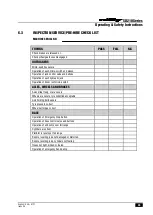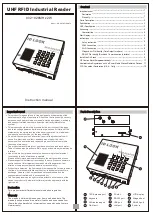
SD210 Series
Operating & Safety Instructions
English / USA – 07/11
Issue 06
37
4.8.5
SETTING TO WORK
Before use each day and at the beginning of each shift the machine shall be given a visual and
functional test including, but not limited to, the following;
1)
Check all lubrication points for adequate application of grease, oil etc.
2)
Inspect all threads for ease or operation.
3)
Check level and quantity of oil. Remove any contaminants - water, etc.
4)
Check battery for electrolyte and state of charge.
5)
Check electrics for damage and insulation.
6)
Using base controls, cycle machine over complete envelope in accordance with the Operating
Instructions. Cure any defects.
7)
Ensure that all safety devices and controls operate in accordance with the instructions.
8)
If necessary, perform a load test to establish the machine stability before putting the machine to
work.
9)
On completion of an extended period of road transport, the machine might need additional
inspection to identify any transit degradation, which could render the machine unsafe. Perform
a P.D.I. inspection on the unit before it enters service. Record any faults found and rectify them
immediately.
10)
If left un-attended for an extended period, it is likely that the hydraulic cage levelling will become
un-pressurised. Normal operation is then lost, with a noticeable delay in the forwards or
backwards motion as the booms move. To restore normal function, the cage needs to be fully
levelled forwards and backwards, using the cage-levelling lever whilst
not
standing in the cage
(i.e. with the operator standing adjacent to the cage side whilst simultaneously operating the
lever and green button to move the cage). Take care not to become trapped between the
moving cage and a fixed object, and ensure those around you are clear of the moving cage.
When the system has been charged in both directions, the cage levelling function should be
restored. If the system operates but is ‘jerky’ in either direction, this indicates air in the system.
Repeat the procedure as described above until the movements are smooth and un-interrupted.
If in doubt, contact our Service Department for further advice.
Niftylift Limited is not liable for any third party damage caused during transport. Careful attention to
correct procedures will prevent many of the small snags that can happen in transit. Re-work is both
expensive and time consuming. A defective machine arriving at the place of work is a poor
advertisement for our product, the company’s reputation and those of our dealers and clients. The
responsibility for safe and damage-free transport rests with the haulier or his representatives.
Summary of Contents for SD210 Series
Page 2: ......








































